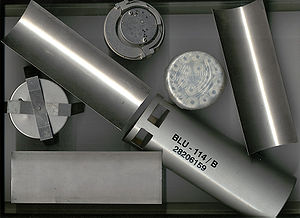
Graphite bomb
Encyclopedia

Electricity
Electricity is a general term encompassing a variety of phenomena resulting from the presence and flow of electric charge. These include many easily recognizable phenomena, such as lightning, static electricity, and the flow of electrical current in an electrical wire...
power systems. Graphite bombs work by spreading a cloud of extremely fine, chemically-treated carbon filaments over electrical components, causing a short-circuit and a disruption of the electrical supply. The filaments are only a few hundredths of an inch thick and can float in the air like a dense cloud. The weapon is sometimes referred to as a "soft bomb" since its effects are largely confined to the targeted electrical power facility, with minimal risk of collateral damage.
The graphite bomb was first used against Iraq
Iraq
Iraq ; officially the Republic of Iraq is a country in Western Asia spanning most of the northwestern end of the Zagros mountain range, the eastern part of the Syrian Desert and the northern part of the Arabian Desert....
in the Gulf War
Gulf War
The Persian Gulf War , commonly referred to as simply the Gulf War, was a war waged by a U.N.-authorized coalition force from 34 nations led by the United States, against Iraq in response to Iraq's invasion and annexation of Kuwait.The war is also known under other names, such as the First Gulf...
(1990 - 1991), knocking out 85% of the electrical supply. Similarly, the BLU-114/B "Soft-Bomb"
BLU-114/B "Soft-Bomb"
The BLU-114/B is a special-purpose munition for attacking electrical power infrastructure. Although very little is known about this highly classified weapon, reportedly it functions by dispensing a number of submunitions which in turn disperse large numbers of chemically treated graphite filaments...
graphite bomb was used by NATO against Serbia
Serbia
Serbia , officially the Republic of Serbia , is a landlocked country located at the crossroads of Central and Southeast Europe, covering the southern part of the Carpathian basin and the central part of the Balkans...
in May of 1999, disabling 70% of that country's power grid. After initial success in disabling Serbian electric power systems, the electric supply was restored in less than 24 hours. The BLU-114/B was again used a few days later to counter Serbian efforts to restore damage caused by the initial attack. In the later stage of Operation ALLIED FORCE
Operation Allied Force
The NATO bombing of Yugoslavia was NATO's military operation against the Federal Republic of Yugoslavia during the Kosovo War. The strikes lasted from March 24, 1999 to June 10, 1999...
, NATO airforce used conventional bombs and rockets to target power highlines and transformer stations. Graphite bombs only work on power lines that are not insulated.

